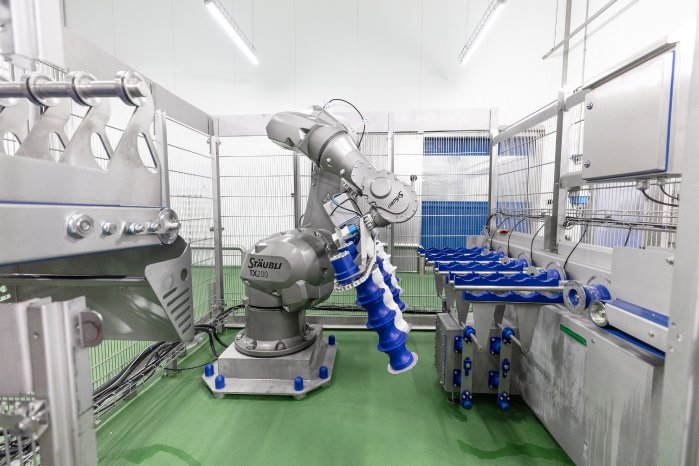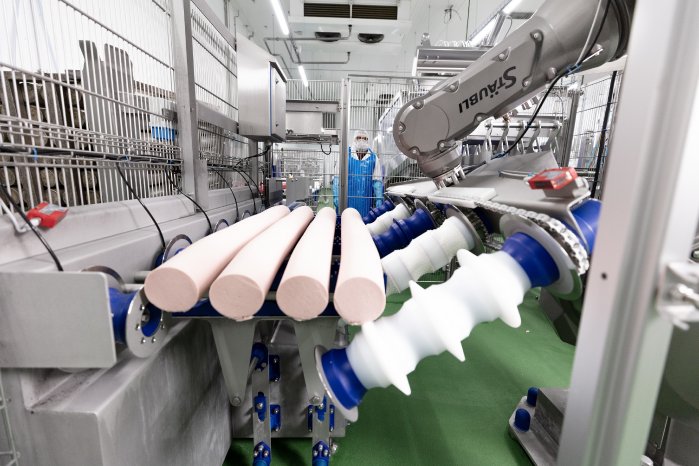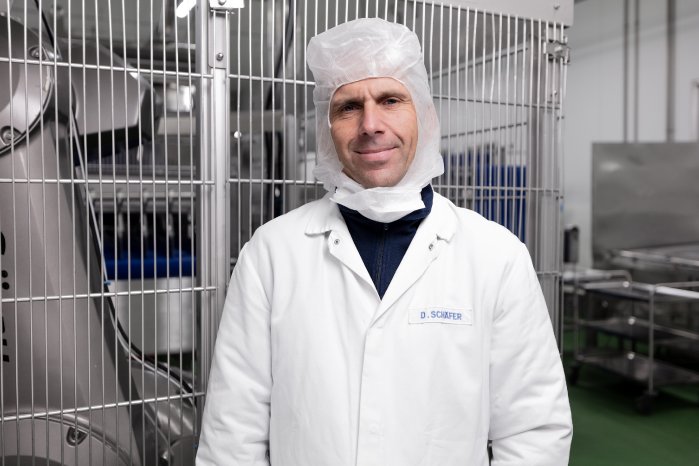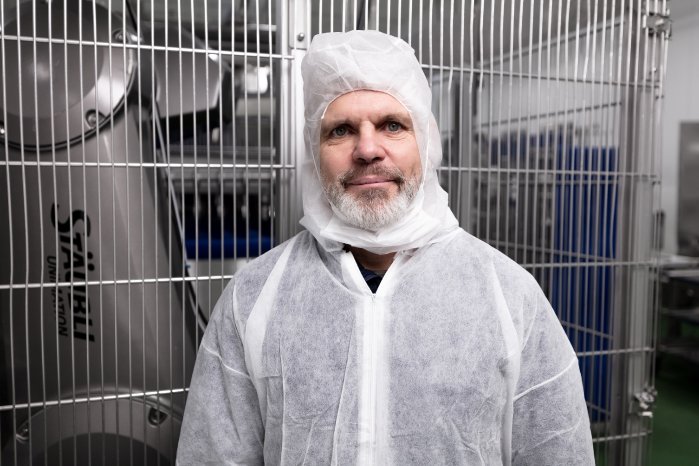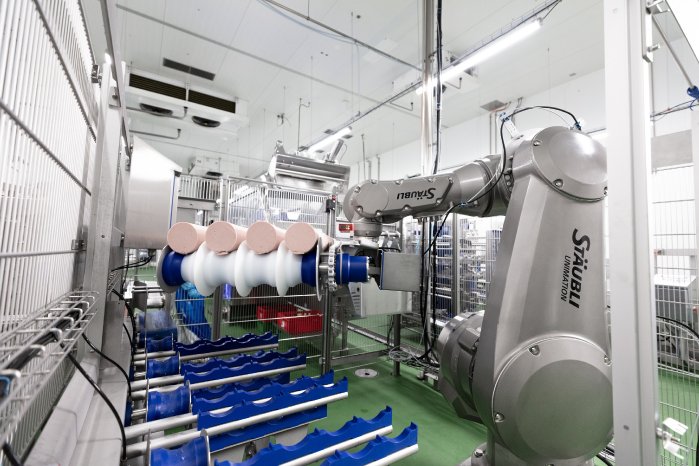In the food industry, the use of robotics always poses certain challenges when food is to be handled prior to wrapping and packaging. If the tasks assigned to a robot bring it into direct contact with the product – in this case sausages – the strictest hygiene standards must be adhered to. Furthermore, the various disinfection processes and intensive washdown of all parts of the system, which are standard in the industry and take place several times a day, almost inevitably rule out the use of standard robots.
Senior management at the Kaufland Fleischwaren sausage plant in Heilbronn, Germany were well aware of these constraints. While they recognized the great advantages that the use of a robot could bring to their production processes, doubts about its suitability clouded their investment decision. “Spending an entire shift loading a slicer with sausages measuring 1,500 millimeters in length and weighing 12 kilos was one of the more unpopular tasks for our employees,” said Dieter Schäfer, packaging team leader at Kaufland Fleischwaren. “In any case, the introduction of more efficient processes in other areas of production meant that this manual part of the line could no longer keep up. The integration of a robot seemed to be the right solution, but we were skeptical as to whether a six-axis machine would be able to withstand our cleaning cycles over a prolonged period.”
Reliable robot under extreme conditions
Martina Düngfelder, Local Head of Life Sciences & Food at Stäubli Robotics, Germany, set herself to the task of dispelling these doubts: “I was aware of Kaufland’s reservations from numerous other projects. But they were easy to assuage, because our washdown-capable HE robots have established themselves as the benchmark for applications under the conditions described and have been proving their reliability in hygiene-sensitive environments for the past 15 years or so.”
Stäubli invited Kaufland’s senior management team to see this for themselves on a tour of several comparable projects, including one in the cheese industry, where Stäubli robots are already firmly established and have been operating reliably for years under the strictest hygiene requirements. Having reassured themselves of the Stäubli robot’s compliance with hygiene standards and resistance to intensive cleaning, the Kaufland management team committed itself to the robotic solution.
Space limitations and gripper technology present the biggest challenge
The right system manufacturer was quickly recruited from within the Stäubli partner network. Aschaffenburg, Germany-based bsb robot systems GmbH has a wealth of experience in automation with robots and was happy to take on the project. What had initially sounded like a simple task – picking up four giant sausages at a defined position and transferring them to the slicer – turned out to be a much trickier undertaking on closer inspection.
Managing Director Rainer Bonfig summarizes the particular challenges: “The daily cleaning procedures were not the problem. We know that Stäubli HE robots can easily handle this. The two problem factors were fitting the robot into a tight space and ensuring that the gripping technology was precise enough to handle the extra-long sausages without damaging them.”
The world’s first robot-assisted slicer loading system
Because the Kaufland slicer is likely the world’s first to be equipped with a six-axis robot loader, it was not possible to fall back on familiar solutions from previous projects. Selecting the right robot was the easy part. Given the harsh disinfection and washdown processes, only a fully enclosed, waterproof Stäubli HE robot could be considered a candidate. And the load capacity and reach factors clearly favored the large TX200 HE, i.e. the specially encapsulated “Humid Environment” version.
This versatile, top-class industrial robot is one of the fastest on the market and sets standards in the areas of hygiene, robustness, dynamics and precision. Designed for extreme cleanroom conditions, the TX200 impresses by virtue of its internal media and supply lines and its fully sealed housing compliant with protection class IP67. Interference contours and dead spaces have been systematically minimized. The housing is made of corrosion-resistant materials so that neither intensive cleaning nor the use of aggressive disinfectants can harm the robot. In addition, this model (like all other Stäubli robots) allows the use of food-grade NSF H1 oil without any loss of performance or speed.
Design par excellence: the gripper
In designing and constructing the gripper, the bsb team drew on their decades of expertise in special machine construction. The solution they came up with was ingenious. The special feature here is that, in order to achieve the specified cycle times, four sausages have to be gripped at once.
To avoid damaging the sausages during the process, bsb devised a special solution. As Bonfig explains, “We designed and built a ‘quadruple roller gripper’. The Stäubli TX200 six-axis positions this under the four sausages at the transfer position and gently lifts them up. The gripper weighs in at just under 80 kilograms and is 1,800 millimeters in width. It has four rollers driven by a central motor for each of the four sausages. The four evenly spaced support points ensure safe lifting and prevent the limp 1,500-millimeter sausages from sagging and splitting.”
The Stäubli TX200 approaches the transfer position with high precision before loading begins. Once the final position has been reached, the central motor sets the gripper’s rollers in motion. In this way, the valuable cargo reaches the slicer infeed reliably and precisely positioned. To prevent the sausages from sliding about on the gripper, the surface of the 3D-printed rollers has a fine spiky surface that ensures the necessary traction during transport.
High output: 6,000 kilos of sliced sausage per shift
With the installation of this globally unique automation system, the Kaufland production facility in Heilbronn now achieves an output of 12,000 kilograms of sliced sausage per day in two-shift operation. No fewer than 21 different types of sausage are now handled by the system. These are combined in four different sausage packaging units and sold in Germany and Eastern Europe.
Dieter Schäfer has more than overcome his initial reservations and is now an enthusiastic advocate of the robot cell: “The Stäubli TX200 HE six-axis robot has completely dispelled my concerns regarding compliance with our strict hygiene standards. The robotic solution also fulfills our other objectives one hundred percent. The lightened load on our employees, the reliable way in which the machine performs on such a small footprint, the increase in productivity, the high availability, the resistance to intensive washdown cleaning, and the exciting new opportunities it presents make this project a complete success in all respects.”
